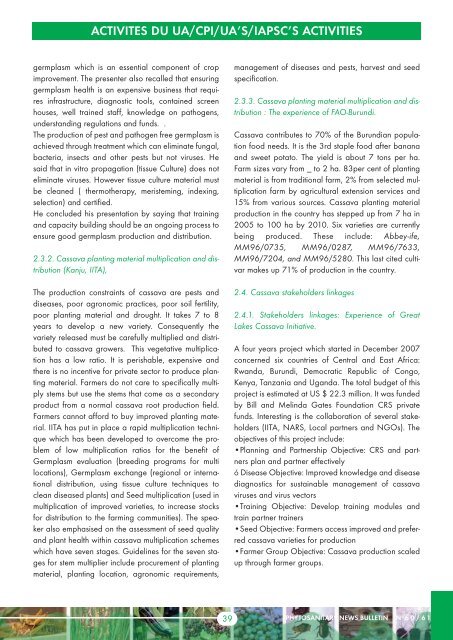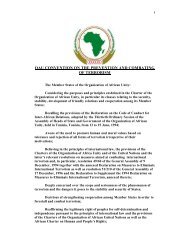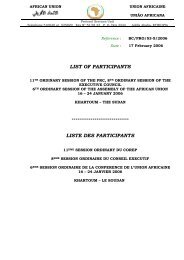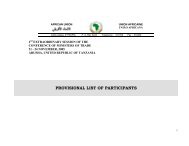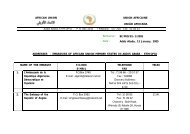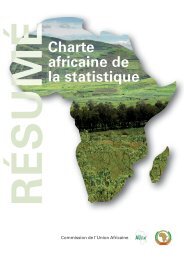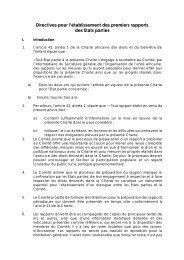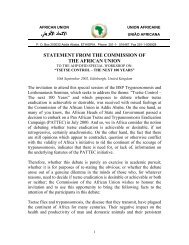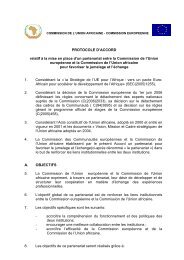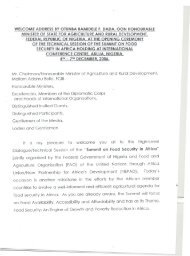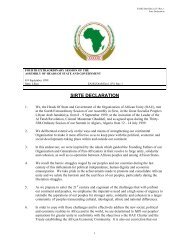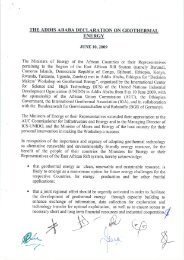BULLETIN D'INFORMATIONS PHYTOSANITAIRES ... - Union africaine
BULLETIN D'INFORMATIONS PHYTOSANITAIRES ... - Union africaine
BULLETIN D'INFORMATIONS PHYTOSANITAIRES ... - Union africaine
- No tags were found...
You also want an ePaper? Increase the reach of your titles
YUMPU automatically turns print PDFs into web optimized ePapers that Google loves.
ACTIVITES DU UA/CPI/UA’S/IAPSC’S ACTIVITIESgermplasm which is an essential component of cropimprovement. The presenter also recalled that ensuringgermplasm health is an expensive business that requiresinfrastructure, diagnostic tools, contained screenhouses, well trained staff, knowledge on pathogens,understanding regulations and funds. .The production of pest and pathogen free germplasm isachieved through treatment which can eliminate fungal,bacteria, insects and other pests but not viruses. Hesaid that in vitro propagation (tissue Culture) does noteliminate viruses. However tissue culture material mustbe cleaned ( thermotherapy, meristeming, indexing,selection) and certified.He concluded his presentation by saying that trainingand capacity building should be an ongoing process toensure good germplasm production and distribution.2.3.2. Cassava planting material multiplication and distribution(Kanju, IITA),The production constraints of cassava are pests anddiseases, poor agronomic practices, poor soil fertility,poor planting material and drought. It takes 7 to 8years to develop a new variety. Consequently thevariety released must be carefully multiplied and distributedto cassava growers. This vegetative multiplicationhas a low ratio. It is perishable, expensive andthere is no incentive for private sector to produce plantingmaterial. Farmers do not care to specifically multiplystems but use the stems that come as a secondaryproduct from a normal cassava root production field.Farmers cannot afford to buy improved planting material.IITA has put in place a rapid multiplication techniquewhich has been developed to overcome the problemof low multiplication ratios for the benefit ofGermplasm evaluation (breeding programs for multilocations), Germplasm exchange (regional or internationaldistribution, using tissue culture techniques toclean diseased plants) and Seed multiplication (used inmultiplication of improved varieties, to increase stocksfor distribution to the farming communities). The speakeralso emphasised on the assessment of seed qualityand plant health within cassava multiplication schemeswhich have seven stages. Guidelines for the seven stagesfor stem multiplier include procurement of plantingmaterial, planting location, agronomic requirements,management of diseases and pests, harvest and seedspecification.2.3.3. Cassava planting material multiplication and distribution: The experience of FAO-Burundi.Cassava contributes to 70% of the Burundian populationfood needs. It is the 3rd staple food after bananaand sweet potato. The yield is about 7 tons per ha.Farm sizes vary from _ to 2 ha. 83per cent of plantingmaterial is from traditional farm, 2% from selected multiplicationfarm by agricultural extension services and15% from various sources. Cassava planting materialproduction in the country has stepped up from 7 ha in2005 to 100 ha by 2010. Six varieties are currentlybeing produced. These include: Abbey-ife,MM96/0735, MM96/0287, MM96/7633,MM96/7204, and MM96/5280. This last cited cultivarmakes up 71% of production in the country.2.4. Cassava stakeholders linkages2.4.1. Stakeholders linkages: Experience of GreatLakes Cassava Initiative.A four years project which started in December 2007concerned six countries of Central and East Africa:Rwanda, Burundi, Democratic Republic of Congo,Kenya, Tanzania and Uganda. The total budget of thisproject is estimated at US $ 22.3 million. It was fundedby Bill and Melinda Gates Foundation CRS privatefunds. Interesting is the collaboration of several stakeholders(IITA, NARS, Local partners and NGOs). Theobjectives of this project include:•Planning and Partnership Objective: CRS and partnersplan and partner effectivelyó Disease Objective: Improved knowledge and diseasediagnostics for sustainable management of cassavaviruses and virus vectors•Training Objective: Develop training modules andtrain partner trainers•Seed Objective: Farmers access improved and preferredcassava varieties for production•Farmer Group Objective: Cassava production scaledup through farmer groups.39PHYTOSANITARY NEWS <strong>BULLETIN</strong> N OS 60/61


